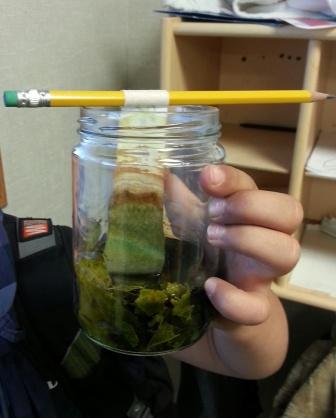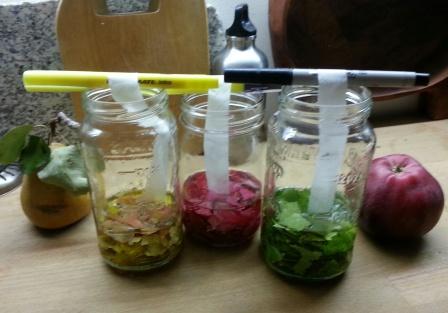Engage students in STEM teaching and learning as they investigate the variables that cause leaves to change color with PLT’s Signs of Fall.
Be sure to check out the full activity found in PLT’s Explore Your Environment: K-8 Activity Guide and PreK-8 Environmental Education Activity Guide.
 Getting Started: The process that produces energy for a tree is called photosynthesis. Photosynthesis is made possible because of the presence of a green pigment called chlorophyll, which gives leaves their green color. Starting in late September, tree leaves undergo a miraculous color change from green to shades of yellow, orange, and red. These changes are triggered when the days get shorter and there is less rainfall. In preparation for winter, broadleaf trees enter into a state of rest and shed their leaves. The first step in the process is to shut off the leaves’ water supply by sealing the connection between the leaves and the stem. This stops photosynthesis and the green chlorophyll pigment is replaced by the other colors (pigments). The first color to dominate the hardwood forest is yellow (xanthophylls), followed by orange (beta-carotene), and finally the reds (anthocyanin).
Getting Started: The process that produces energy for a tree is called photosynthesis. Photosynthesis is made possible because of the presence of a green pigment called chlorophyll, which gives leaves their green color. Starting in late September, tree leaves undergo a miraculous color change from green to shades of yellow, orange, and red. These changes are triggered when the days get shorter and there is less rainfall. In preparation for winter, broadleaf trees enter into a state of rest and shed their leaves. The first step in the process is to shut off the leaves’ water supply by sealing the connection between the leaves and the stem. This stops photosynthesis and the green chlorophyll pigment is replaced by the other colors (pigments). The first color to dominate the hardwood forest is yellow (xanthophylls), followed by orange (beta-carotene), and finally the reds (anthocyanin).
Essential Question: What changes occur in a tree leaf when it changes color from green to red?
Task: Select a hardwood tree at your school or home and predict what color the leaves will become. (NGSS Connection: MS-LS1 From Molecules to Organisms: Structures and Processes: L S1.A (MS-LS-1))
STEM Strategies
Science
Science concepts can be used to help students explore and understand the biological significance of leaf color change. For example, red leaves contain the pigment anthocyanin, which is a strong antioxidant. Antioxidants are essential to both plant and human health. Create a list of foods that you eat that contain high levels of antioxidants.
Technology
Technology can be used to inventory hardwood trees in your community and document their color change over time. You might use existing tree images from the internet or forestry magazines or use a digital camera to capture your own. Challenge students to create a collage using the colorful images of fall trees in your area.

Engineering
Engineering can be used to investigate a green leaf’s future color change. Collect green leaves, shred them into tiny pieces, and place them in a mason jar. Cover the leaves with rubbing alcohol, and insert a cut strip of coffee filter into the jar. See what happens overnight! Try different versions of this experiment—for example, what happens if you do the experiment again with leaves that have already turned color? What happens if you use leaves from different tree species?
Math
Math can be used to analyze tree leaf data. Take students outdoors to collect fallen leaves of many different colors. Students can practice measurement by calculating the total length and width of each leaf. Are red leaves bigger than yellow leaves? Challenge students to compile, analyze, and display the leaf data they collect. How many total brown, yellow, green and red leaves were collected? Have students use different graph types to display this information. Depending on the age of your students, you might instruct them to use specific graphs (line, bar, pie) or allow them to self-select.
Additional Resources
This activity can be found in PLT’s Explore Your Environment: K-8 Activity Guide and/or PLT’s PreK-8 Environmental Education Activity Guide.
- Purchase a print guide or e-book, available from PLT.org, Amazon and other places where books are sold.
- Get it through your PLT State Coordinator along with hands-on professional development, alignments to state standards and other state-specific supporting resources.
- Read our Educator Tips article What Makes Trees So Colorful in the Fall? for more suggestions to help students discover visible and invisible changes in autumn leaves.
Don’t consider yourself a formal teacher?
- Check out PLT’s Signs of Fall family activity. We have 40+ nature activities for families that can be easily used by parents, grandparents, youth group leaders, nature centers, and other nonformal programs.



